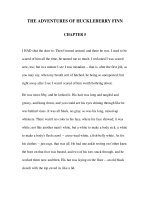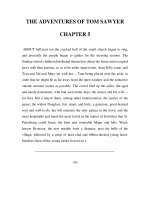Lecture Management of retail buying – Chapter 5: Planning and control
Bạn đang xem bản rút gọn của tài liệu. Xem và tải ngay bản đầy đủ của tài liệu tại đây (234.2 KB, 5 trang )
Ch. 5: Planning & Control
• How budgets are determined (& checked
periodically) for a buying season or dept.
• Stockturn & how to determine the productivity
of the merchandise as an investment
• Staple stock controls, or how stores ensure
their basics & bestsellers are always
available
• Factors to consider when dealing with
seasonal merchandise
• How to buy even when the budget is very
tight
Copyright © 2006 by John Wiley & Sons, Inc. All rights rese
Determining a Planned Purchase Amount
Sales for the month
+ Markdowns for the month
+ Stock required at end of month (EOM) or
beginning of following month (BOM)
– Stock provided (on hand) at start of month
= Planned purchase for the month
Copyright © 2006 by John Wiley & Sons, Inc. All rights rese
Correcting OTB Budget Problems:
Is the OpenToBuy amount…
Less than what More than what
buyer needs? buyer needs?
• Incorrect forecasting
(planning errors)
• Improper distribution of
merchandise mix (buying
errors)
• Unsuccessful promotions
• Late receipt of goods
(timing errors)
• Incorrect forecasting
(planning errors)
• Insufficient amounts
purchased (buying
errors)
• Unexpectedly successful
promotions
• Failure to place orders
on a timely basis (timing
errors)
Copyright © 2006 by John Wiley & Sons, Inc. All rights rese
Keeping Inventory Low (but not too low!)
•
•
•
•
•
•
Reduce number of price lines
Avoid similar styles or brands
Eliminate slowselling items or lines
Buy more frequently, in smaller quantities
Reduce staple stock amounts slightly
Create a system to mark incoming stock by
date, then mark it down or promote it at
regular, timed intervals to prompt sales
Copyright © 2006 by John Wiley & Sons, Inc. All rights rese
Stock Controls: When & how much to order
• The point is to reduce outofstock incidences without having too
much merchandise in inventory.
• Depending on type of merchandise, reordering is done by:
Continuous replenishment
Long commitment (major initial order) with subsequent
readjustments to reorders
Long commitment with little or no reordering
• Facts necessary for stock control of any item:
listing and description of item probable rate of sale
reorder period reserve
provision (maximum) amount unit OTB (minimum)
current stock on hand stock on order
Copyright © 2006 by John Wiley & Sons, Inc. All rights rese









